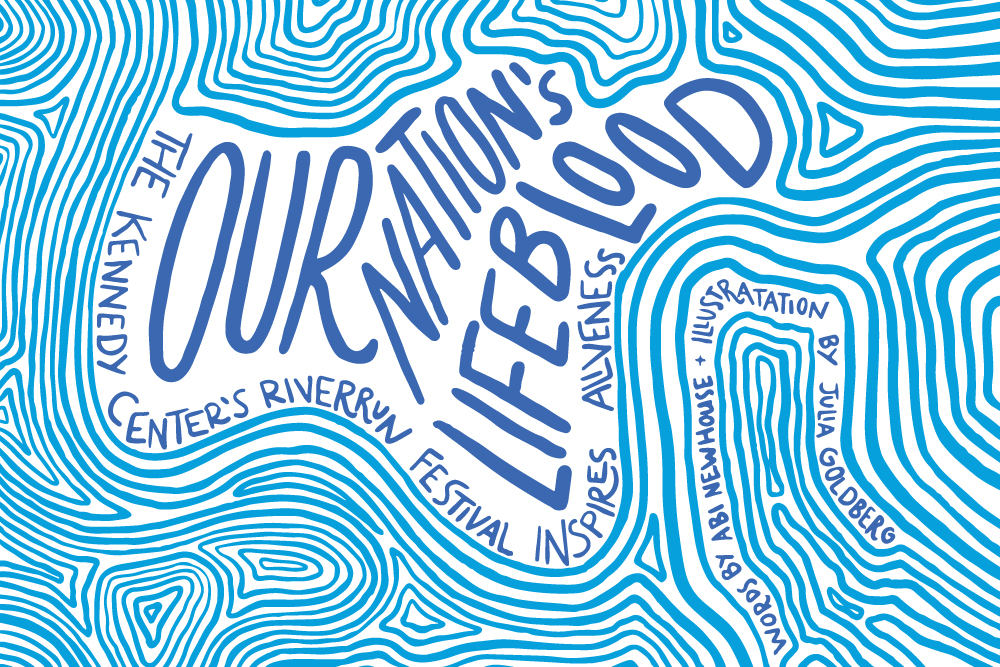Culture
 Illustration by Julia Goldberg.
Illustration by Julia Goldberg.
The Kennedy Center’s RiverRun Festival Inspires Aliveness
March 23, 2023 @ 12:00pm
The Kennedy Center created the RiverRun festival to celebrate the world’s rivers, and the “Ferry Tales” exhibit highlights the wonders of D.C.’s very own Potomac.
Look at the Potomac’s river system from high enough, and it starts to resemble veins, arteries, nervous systems. The river stretches from the Chesapeake Bay across three different states — West Virginia, Maryland and Virginia — and connects with other rivers and creeks to create this bodily shape, one reminiscent of the veins in our eyes, the lines on our hands. It shouldn’t be surprising, then, to hear that American Rivers calls the Potomac “the lifeblood of our nation.” It’s alive, it helps keep us alive and it’s being celebrated along with other world rivers at the Kennedy Center’s RiverRun Festival, from March 22 to April 22.
The festival celebrates how rivers shape cultures, sustain life and inspire art of all kinds. RiverRun kicks off a decade of Kennedy Center programs dedicated to the protection and conservation of our environment, the rest of which will take us to space, dive deep into energy sources and hopefully, at the end of the decade, highlight the peace we’ve made with nature.
RiverRun programming includes music and dance performances, multimedia concerts, illusionists, theatre, art installations, documentaries, literature readings, food and other exhibits focusing on rivers around the world — the Ganges, the Río de la Plata and the Mississippi, among others.
“I always think of our festivals as being knowledge, an opportunity for people to learn about arts and culture from other places in a meaningful way,” says Alicia Adams, Kennedy Center’s vice president of dance and international programming. “Rivers are the basis for civilization, and without them civilization could not have grown in the way that it did.”
One performance specific to the Potomac called “Ferry Tales” will have storytellers stationed along the river sharing tales of its science, history and folklore. “Ferry Tales” is directed by Caitlin Nasema Cassidy, co-artistic director of LubDub Theatre Co. Currently, Cassidy is also the 2022-23 artist-in-residence at Georgetown University’s The Earth Commons Institute, an environment and sustainability program she helped pioneer to connect science and humanities.
“For me it’s, ‘How can the medium of performance and storytelling specifically meet this moment we’re alive in?’” Cassidy says. “Theatre has this powerful immediacy to remind people we are interconnected, and we have to be better stewards.”
The Kennedy Center knew this partnership would give the younger generation a chance to communicate their point of view, creating a fuller scope of what rivers mean to people past and present.
“In many ways, they are the river,” Adams says. “The drivers of it. They’re making their parents do certain things to live sustainable lives. It’s important they’re engaged.”
Cassidy worked with Georgetown-alumni artists to conduct interviews with geologists, ornithologists, riverkeepers, D.C. natives and Indigenous stewards. They created stories from what they learned.
“The river is so full of ghosts and also so full of life,” Cassidy says. “We are focusing not just on human stories around the Potomac, but also on the critters and plants and microbes — the things people may not see or know about, but which are so vital to the ecosystem.”
The tales will be woven together and performed by people in costume, so even passersby with no knowledge of the festival can participate.
“My great hope is that people will see the performers glimmer or sparkle by the water and be drawn to come sit down and learn about the mussels and the dolphins and the shads,” Cassidy says.
Cassidy reiterated just how alive the river is — especially beneath the surface. To regular citizens on walks near the river’s edge, the aliveness comes from the steady rush of the water flowing, but scientists are working to understand the ever-changing environment we don’t see. Cassidy mentioned Janet Mann, a scientist at Georgetown studying the return of dolphins to the Potomac.
“She’s noticing thousands of them,” Cassidy says. “They are a direct result of the shad fish population coming back, which then brought the dolphins, too.”
Nature finds a way to balance itself even when humans tip the scales. The Potomac’s cleanliness has ebbed and flowed over the years, and all over the world, rivers are drying up or being poisoned with manmade contaminants. RiverRun will look at it all — the return of the dolphins and the reasons they left — to help citizens think a little deeper about how we can protect the lifeblood around us.
“We want people to see the beauty and necessity of rivers,” Adams says. “This will lead them to understanding the water and why it’s so important that we change our lives.”
To Cassidy, focusing on the river’s aliveness helps her enter a storytelling mode that is celebratory, liberating.
“My job as an artist is to point and say to people, look how alive this is, and its aliveness is connected to your aliveness,” she says. “It’s a relationship.”
Think again of our veins, a flower’s roots, a tree’s branches, rivers running from above. The Kennedy Center’s RiverRun Festival asks participants to open their eyes, to bask in the beauty, life and art rivers inspire. Then sit by the water, close your eyes, listen — let it all sink in.
The Kennedy Center’s RiverRun Festival takes place until April 22. Check out a full list of events at kennedy-center.org.
The Kennedy Center: 2700 F St. NW, DC; kennedy-center.org // @kennedycenter
The Aliveness in the Potomac
In 1965, President Johnson declared the Potomac a “national disgrace.” But ever since then, biologists and riverkeepers have worked to clean it up — so much so that humans should be able to swim in it soon. And with that cleanliness, pivotal species have returned.
“Reintroduction programs in the Potomac are amazing — they’ve actually been quite successful,” says Dean Naujoks of the Potomac Riverkeeper Network. Here are a few different creatures giving life to our rivers, with insight from Naujoks on their importance for our ecosystem.
Bottlenose Dolphin
In the Potomac, dolphins are apex predators, which means their presence helps keep the ecosystem in balance. They have been spotted as far north as Dahlgren, Virginia, near the 301 bridge.
Atlantic Sturgeon
“They’re returning in big numbers to the river,” Naujoks says. These fish are prehistoric — and they don’t have scales. They have scutes, like plates of armor. As an endangered species, it’s exciting to see them lurking at the bottom of the river.
American Shad
After swimming in the ocean for a few years, American shad come to rivers like the Potomac to spawn, providing an important link in the area’s food chain. “If you go to Fletchers Cove up in D.C., you’ll see literally dozens of people in row boats catching shad,” Naujoks says.
Blue Catfish
These are invasive and wreaking havoc on the Potomac. Several fisheries in the region are harvesting them, though, to control the population. “I recently ate blue catfish in a curry sauce at a restaurant,” Naujoks says. “It’s delicious. We need more restaurants using these fish. We have better tasting invasives right here in the Potomac River than [fish] sourced elsewhere.” Look closely at the fish on menu next time you go out — it’s a tasty way to help the river.
Eastern Lampmussel
In 2019, the Potomac Riverkeeper Network piloted the 50 Million Mussel Project to bring back this valuable creature. The Eastern Lampmussel lives in the Anacostia and Potomac, helping filter toxins, nutrients and sediments (nine to 20 gallons a day) from the water to make rivers safer for their inhabitants — and for us, too.
Eelgrass
This aquatic seagrass is an unsung hero of climate change. Restoration projects in the Chesapeake Bay and our river system have seen success, giving more carbon-capturing plants to the D.C. area.
Want first access to select shows, exhibits and performances around the city? Join the District Fray community to access free and discounted tickets. Become a member and support local journalism today.







